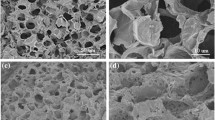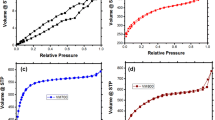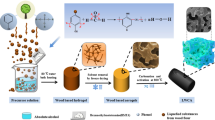Abstract
The facile preparation of porous carbon monolith electrodes as a supercapacitor was demonstrated using rubber wood wastes treated with NaOH or H3PO4 as starting materials. Different concentrations of treating solutions were used (5 and 10% w/v). The effect of the pore structures of the porous carbon electrodes on their electrochemical performance and which parameters played important roles in the specific capacitance were also studied. The results revealed that the H3PO4-activated samples had microporous characteristics and a specific surface area of 605–693 m2/g, while the NaOH-activated samples exhibited mesoporous characteristics with a developed mesopore volume of 0.27 cm3/g. The specific surface area tended to increase with an increased H3PO4 concentration but decreased with an increased NaOH concentration. As confirmed by X-ray photoelectron spectrophotometry, oxygenated functional groups (OGF) were detected in all samples. Notwithstanding, a pseudo-Faradaic reaction as a result of OGF occurred only with the reference carbon and H3PO4-activated samples, while NaOH-activated samples with OGF exhibited ideal electrical double-layer capacitor behavior. Measured at 1 mV/s in 1 M H2SO4 solution, a carbon electrode prepared from 10% w/v H3PO4-treated rubber wood exhibited the maximum gravimetric capacitance of 129 F/g, a volumetric capacitance of 104 F/cm3, an energy density of 14.2 Wh/kg, and a power density of 500 W/kg. The results also showed that the mesopore volume and the average pore size rather than the specific surface area played important roles in the specific capacitance, but only when the percentage difference in the specific surface area between the two samples did not exceed 41%.









Similar content being viewed by others
References
Yang KS, Kim B-H (2015) Highly conductive, porous RuO2/activated carbon nanofiber composites containing graphene for electrochemical capacitor electrodes. Electrochim Acta 186:337–344
Hsieh C-T, Tzou D-Y, Lee W-Y, Hsu J-P (2016) Deposition of MnO2 nanoneedles on carbon nanotubes and graphene nanosheets as electrode materials for electrochemical capacitors. J Alloys Compd 660:99–107
Jin X-J, Zhang M-Y, Wu Y, Zhang J, Mu J (2013) Nitrogen-enriched waste medium density fiberboard-based activated carbons as materials for supercapacitors. Ind Crops Prod 43:617–622
Braghiroli FL, Fierro V, Szczurek A, Stein N, Parmentier J, Celzard A (2015) Electrochemical performances of hydrothermal tannin-based carbons doped with nitrogen. Ind Crops Prod 70:332–340
Wang Y, Yang R, Li M, Zhao Z (2015) Hydrothermal preparation of highly porous carbon spheres from hemp (Cannabis sativa L.) stem hemicellulose for use in energy-related applications. Ind Crops Prod 65:216–226
Wang L, Zhang H, Cao G, Zhang W, Zhao H, Yang Y (2015) Effect of activated carbon surface functional groups on nano-lead electrodeposition and hydrogen evolution and its applications in lead-carbon batteries. Electrochim Acta 186:654–663
Li Y, Huang Y, Zhang Z, Duan D, Hao X, Liu S (2016) Preparation and structural evolution of well aligned-carbon nanotube arrays onto conductive carbon-black layer/carbon paper substrate with enhanced discharge capacity for Li–air batteries. Chem Eng J 283:911–921
Conway BE (1999) Electrochemical supercapacitors: scientific fundamentals and technological applications. Kluwer Academic/Plenum, New York
Kotz R, Carlen M (2000) Principles and applications of electrochemical capacitors. Electrochim Acta 45:2483–2498
Qu D, Shi H (1998) Studies of activated carbons used in double-layer capacitors. J Power Sour 74:99–107
Katanyoota P, Chaisuwan T, Wongchaisuwat A, Wongkasemjit S (2010) Novel polybenzoxazine-based carbon aerogel electrode for supercapacitors. Mater Sci Eng B 167:36–42
Liu M-C, Kong L-B, Zhang P, Luo Y-C, Kang L (2012) Porous wood carbon monolith for high-performance supercapacitors. Electrochim Acta 60:443–448
Christinelli WA, Goncalves R, Pereira EC (2016) A new generation of electrochemical supercapacitors based on layer-by-layer polymer films. J Power Sour 303:73–80
Ali GAM, Wahba OAG, Hassan AM, Fouad OA, Chong KF (2015) Calcium-based nanosized mixed metal oxides for supercapacitor application. Ceram Int 41:8230–8234
Liu C, Yu Z, Neff D, Zhamu A, Jang BZ (2010) Graphene-based supercapacitor with an ultrahigh energy density. Nano Lett 10:4863–4868
Attia AA, Girgis BS, Fathy NA (2008) Removal of methylene blue by carbons derived from peach stones by H3PO4 activation: batch and column studies. Dyes Pigm 76:282–289
Gao F, Zhang L, Huang S (2010) Fabrication horizontal aligned MoO2/single-walled carbon nanotube nanowires for electrochemical supercapacitor. Mater Lett 64:537–540
Qian Y, Lu S, Gao F (2011) Preparation of MnO2/graphene composite as electrode material for supercapacitors. J Mater Sci 46:3517–3522. doi:10.1007/s10853-011-5260-y
Ismanto AE, Wang S, Soetaredjo FE, Ismadji S (2010) Preparation of capacitor’s electrode from cassava peel waste. Bioresour Technol 101:3534–3540
Taer E, Deraman M, Talib IA, Umar AA, Oyama M, Yunus RM (2010) Physical, electrochemical and supercapacitive properties of activated carbon pellets from pre-carbonized rubber wood sawdust by CO2 activation. Curr Appl Phys 10:1071–1075
Farma R, Deraman M, Awitdrus A, Talib IA, Taer E, Basri NH, Manjunatha JG, Ishak MM, Dollah BNM, Hashmi SA (2013) Preparation of highly porous binderless activated carbon electrodes from fibres of oil palm empty fruit bunches for application in supercapacitors. Bioresour Technol 132:254–261
Syarif N, Tribidasari IA, Wibowo W (2013) Binder-less activated carbon electrode from gelam wood for use in supercapacitors. J Electrochem Sci Eng 3:37–45
Taer E, Deraman M, Talib IA, Awitdrus A, Hashmi SA, Umar AA (2011) Preparation of a highly porous binderless activated carbon monolith from rubber wood sawdust by a multi-step activation process for application in supercapacitors. Int J Electrochem Sci 6:3301–3315
Huang Y, Li S, Lin H, Chen J (2014) Fabrication and characterization of mesoporous activated carbon from Lemna minor using one-step H3PO4 activation for Pb(II) removal. Appl Surf Sci 317:422–431
Jain A, Balasubramanian R, Srinivasan MP (2015) Production of high surface area mesoporous activated carbons from waste biomass using hydrogen peroxide-mediated hydrothermal treatment for adsorption applications. Chem Eng J 273:622–629
Jain A, Xu C, Jayaraman S, Balasubramanian R, Lee JY, Srinivasan MP (2015) Mesoporous activated carbons with enhanced porosity by optimal hydrothermal pre-treatment of biomass for supercapacitor applications. Microporous Mesoporous Mater 218:55–61
Wu F-C, Tseng R-L, Hu C-C, Wang C-C (2005) Effects of pore structure and electrolyte on the capacitive characteristics of steam- and KOH-activated carbons for supercapacitors. J Power Sour 144:302–309
Kim C, Lee J-W, Kim J-H, Yang K-S (2016) Feasibility of bamboo-based activated carbons for an electrochemical supercapacitor electrode. Korean J Chem Eng 23:592–594
Jisha MR, Hwang YJ, Shin JS, Nahm KS, Prem Kumar T, Karthikeyan K, Dhanikaivelu N, Kalpana D, Renganathan NG, Stephan AM (2009) Electrochemical characterization of supercapacitors based on carbons derived from coffee shells. Mater Chem Phys 15:33–39
Li H, Xi H, Zhu S, Wen Z, Wang R (2016) Preparation, structural characterization, and electrochemical properties of chemically modified mesoporous carbon. Microporous Mesoporous Mater 96:357–362
Srinivasakannan C, Bakar MZA (2004) Production of activated carbon from rubber wood sawdust. Biomass Bioenergy 27:89–96
Helen Kalavathy M, Regupathi I, Pillai MG, Miranda LR (2009) Modelling, analysis and optimization of adsorption parameters for H3PO4 activated rubber wood sawdust using response surface methodology (RSM). Coll Surf B 70:35–45
Raymundo-Pinero E, Azais P, Cacciaguerra T, Cazorla-Amoros D, Linares-Solano A, Beguin F (2005) KOH and NaOH activation mechanisms of multiwalled carbon nanotubes with different structural organisation. Carbon 43:786–795
Perrin A, Celzard A, Albiniak A, Kaczmarczyk J, Mareche JF, Furdin G (2004) NaOH activation of anthracites: effect of temperature on pore textures and methane storage ability. Carbon 42:2855–2866
Lillo-Rodenas MA, Cazorla-Amoros D, Linares-Solano A (2003) Understanding chemical reactions between carbons and NaOH and KOH: an insight into the chemical activation mechanism. Carbon 41:267–275
Lillo-Rodenas MA, Juan-Juan J, Cazorla-Amoros D, Linares-Solano A (2004) About reactions occurring during chemical activation with hydroxides. Carbon 42:1371–1375
Romanos J, Beckner M, Rash T, Firlej L, Kuchta B, Yu P, Suppes G, Wexler C, Pfeifer P (2012) Nanospace engineering of KOH activated carbon. Nanotechnology 23:015401. doi:10.1088/0957-4484/23/1/015401
Wang J, Kaskel S (2012) KOH activation of carbon-based materials for energy storage. J Mater Chem 22:23710–23725
Brunauer S, Emmett PH, Teller E (1938) Adsorption of gases in multimolecular layers. J Am Chem Soc 60:309–319
Lippens BC, de Boer JH (1965) Studies on pore systems in catalysts: V. The t method. J Catal 4:319–323
Wu D, Fu R, Dresselhaus MS, Dresselhaus G (2006) Fabrication and nano-structure control of carbon aerogels via a microemulsion-templated sol-gel polymerization method. Carbon 44:675–681
Rouquerol F, Rouquerol J, Sing K (1999) Adsorption by powders and porous solids principles, methodology and applications. Academic Press, London
Hsu L-Y, Teng H (2000) Influence of different chemical reagents on the preparation of activated carbons from bituminous coal. Fuel Process Technol 64:155–166
Williams PT, Reed AR (2004) High grade activated carbon matting derived from the chemical activation and pyrolysis of natural fibre textile waste. J Anal Appl Pyrolysis 71:971–986
Donald J, Ohtsuka Y, Xu C (2011) Effects of activation agents and intrinsic minerals on pore development in activated carbons derived from a Canadian peat. Mater Lett 65:744–747
Teng H, Yeh TS, Hsu LY (1998) Preparation of activated carbon from bituminous coal with phosphoric acid activation. Carbon 36:1387–1395
Prahas D, Kartika Y, Indraswati N, Ismadji S (2008) Activated carbon from jackfruit peel waste by H3PO4 chemical activation: pore structure and surface chemistry characterization. Chem Eng J 140:32–42
Yahya MA, Al-Qodah Z, Zanariah Ngah CW (2015) Agricultural bio-waste materials as potential sustainable precursors used for activated carbon production: a review. Renew Sustain Energy Rev 46:218–235
Yorgun S, Yıldız D (2015) Preparation and characterization of activated carbons from Paulownia wood by chemical activation with H3PO4. J Taiwan Inst Chem Eng 53:122–131
Huang Y, Ma E, Zhao G (2015) Thermal and structure analysis on reaction mechanisms during the preparation of activated carbon fibers by KOH activation from liquefied wood-based fibers. Ind Crops Prod 69:447–455
Thubsuang U, Sukanan D, Sahasithiwat S, Wongkasemjit S, Chaisuwan T (2015) Highly sensitive room temperature organic vapor sensor based on polybenzoxazine-derived carbon aerogel thin film composite. Mater Sci Eng B 200:67–77
Zhang J, Gong L, Sun K, Jiang J, Zhang X (2012) Preparation of activated carbon from waste Camellia oleifera shell for supercapacitor application. J Solid State Electrochem 16:2179–2186
Thubsuang U, Ishida H, Wongkasemjit S, Chaisuwan T (2014) Self-formation of 3D interconnected macroporous carbon xerogels derived from polybenzoxazine by selective solvent during the sol-gel process. J Mater Sci 49:4946–4961. doi:10.1007/s10853-014-8196-1
Dey S, Anderson ST, Mayanovic RA, Sakidja R, Landskron K, Kokoszka B, Mandal M, Wang Z (2016) Experimental and theoretical investigation of a mesoporous K x WO3 material having superior mechanical strength. Nanoscale 8:2937–2943
Rufford TE, Hulicova-Jurcakova D, Khosla K, Zhu Z, Lu GQ (2010) Microstructure and electrochemical double-layer capacitance of carbon electrodes prepared by zinc chloride activation of sugar cane bagasse. J Power Sour 195:912–918
Rufford TE, Hulicova-Jurcakova D, Zhu Z, Lu GQ (2008) Nanoporous carbon electrode from waste coffee beans for high performance supercapacitors. Electrochem Commun 10:1594–1597
Wang H, Peng H, Li G, Chen K (2015) Nitrogen-containing carbon/graphene composite nanosheets with excellent lithium storage performances. Chem Eng J 275:160–167
Puziy AM, Poddubnaya OI, Socha RP, Gurgul J, Wisniewski M (2008) XPS and NMR studies of phosphoric acid activated carbons. Carbon 46:2113–2123
Wan L, Wang J, Xie L, Sun Y, Li K (2014) Nitrogen-enriched hierarchically porous carbons prepared from polybenzoxazine for high-performance supercapacitors. ACS Appl Mater Interfaces 6:15583–15596
Rennie AJR, Hall PJ (2013) Nitrogen-enriched carbon electrodes in electrochemical capacitors: investigating accessible porosity using CM-SANS. Phys Chem Chem Phys 15:16774–16778
Hulicova-Jurcakova D, Seredych M, Lu GQ, Bandosz TJ (2009) Combined effect of nitrogen- and oxygen-containing functional groups of microporous activated carbon on its electrochemical performance in supercapacitors. Adv Funct Mater 19:438–447
Frackowiak E, Beguin F (2001) Carbon materials for the electrochemical storage of energy in capacitors. Carbon 39:937–950
Welch CM, Smith HA (1953) Reactions of carboxylic acids in sulfuric acid. J Am Chem Soc 75:1412–1415
Fang B, Binder L (2006) A modified activated carbon aerogel for high-energy storage in electric double layer capacitors. J Power Sour 163:616–622
Gogotsi Y, Simon P (2011) True performance metrics in electrochemical energy storage. Science 334:917–918
Wang Q, Yan J, Fan Z (2016) Carbon materials for high volumetric performance supercapacitors: design, progress, challenges and opportunities. Energy Environ Sci 9:729–762
Kawaguchi M, Itoh A, Yagi S, Oda H (2007) Preparation and characterization of carbonaceous materials containing nitrogen as electrochemical capacitor. J Power Sour 172:481–486
Xu B, Wu F, Chen S, Zhou Z, Cao G, Yang Y (2009) High-capacitance carbon electrode prepared by PVDC carbonization for aqueous EDLCs. Electrochim Acta 54:2185–2189
Olivares-Marin M, Fernandez JA, Lazaro MJ, Fernandez-Gonzalez C, Macias-Garcia A, Gomez-Serrano V, Stoeckli F, Centeno TA (2009) Cherry stones as precursor of activated carbons for supercapacitors. Mater Chem Phys 114:323–327
Acknowledgements
The authors would like to express their deep appreciation to the Research Center of Excellence on Wood Science and Engineering, School of Engineering and Resources, Walailak University, and the Ratchadaphiseksomphot Endowment Fund, Chulalongkorn University, for financial supporting this research. In addition, special thanks also go to Prof. Suwabun Chirachanchai for his kind support with the potentiostat and to Dr. Andrew John Warner for proofreading this manuscript.
Author information
Authors and Affiliations
Corresponding author
Electronic supplementary material
Below is the link to the electronic supplementary material.
Rights and permissions
About this article
Cite this article
Thubsuang, U., Laebang, S., Manmuanpom, N. et al. Tuning pore characteristics of porous carbon monoliths prepared from rubber wood waste treated with H3PO4 or NaOH and their potential as supercapacitor electrode materials. J Mater Sci 52, 6837–6855 (2017). https://doi.org/10.1007/s10853-017-0922-z
Received:
Accepted:
Published:
Issue Date:
DOI: https://doi.org/10.1007/s10853-017-0922-z




